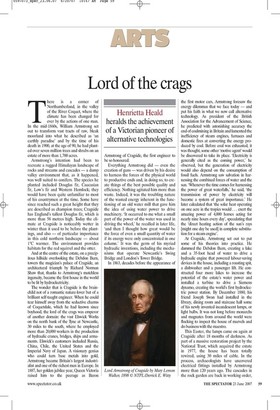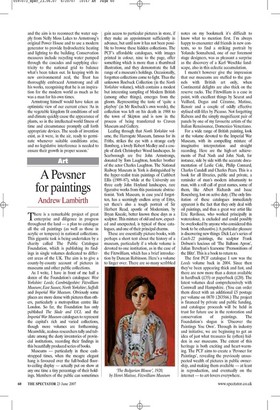Lord of the crags
Henrietta Heald heralds the achievement of a Victorian pioneer of alternative technologies There is a corner of Northumberland, in the valley of the River Coquet, where the climate has been changed for ever by the actions of one man. In the mid-1860s, William Armstrong set out to transform vast tracts of raw, bleak moorland into what he described as 'an earthly paradise' and by the time of his death in 1900, at the age of 90, he had planted over seven million trees and shrubs on an estate of more than 1,700 acres.
Armstrong's intention had been to recreate a rugged Himalayan landscape of rocks and streams and cascades — a damp valley environment that, as it happened, was well suited to conifers. The species he planted included Douglas fir, Caucasian fir, Low's fir and Western Hemlock; they would have been quite unfamiliar to most of his countrymen at the time. Some have since reached such a great height that they are described as champion trees; Cragside has England's tallest Douglas fir, which is more than 58 metres high. Today the climate at Cragside is noticeably wetter in winter than it used to be before the plantings, and also — of particular importance in this cold northern landscape — about 1°C warmer. The environment provides habitats for the red squirrel and the otter.
And at the centre of the estate, on a precipitous hillside overlooking the Debdon Burn, towers the magician's palace of Cragside, an architectural triumph by Richard Norman Shaw that, thanks to Armstrong's matchless ingenuity, became the first house in the world to be lit by hydroelectricity.
The wonder that is Cragside is the brainchild not of a romantic nature-lover but of a brilliant self-taught engineer. When he could tear himself away from the seductive charms of Coquetdale, which he had known since boyhood, the lord of the crags was emperor of another domain: the vast Elswick Works on the north bank of the Tyne at Newcastle, 30 miles to the south, where he employed more than 20,000 workers in the production of hydraulic cranes, bridges, ships and armaments. Elswick's customers included Russia, China, Chile, the United States and the Imperial Navy of Japan. A visionary genius who could turn base metals into gold, Armstrong became Britain's largest industrialist and one of the richest men in Europe. In 1887, her golden jubilee year, Queen Victoria raised him to the peerage as Baron Armstrong of Cragside, the first engineer to be so honoured.
Everything Armstrong did — even the creation of guns — was driven by his desire to harness the forces of the physical world to productive ends and, in doing so, to create things of the best possible quality and efficiency. Nothing agitated him more than waste. Indeed, it was the troubling nature of the wasted energy inherent in the functioning of an old water mill that gave him the idea of using water power to drive machinery. 'It occurred to me what a small part of the power of the water was used in driving the wheel,' he recalled in later life, 'and then I thought how great would be the force of even a small quantity of water if its energy were only concentrated in one column.' It was the germ of his myriad hydraulic inventions, including the mechanisms that operate Newcastle's Swing Bridge and London's Tower Bridge.
In 1863, decades before the appearance of the first motor cars, Armstrong foresaw the energy dilemmas that we face today — and put his faith in what we now call alternative technology. As president of the British Association for the Advancement of Science, he predicted with astonishing accuracy the end of coalmining in Britain and lamented the inefficiency of steam engines, furnaces and domestic fires at converting the energy produced by coal. Before coal was exhausted, it was thought, some other 'motive agent' would be discovered to take its place. 'Electricity is generally cited as the coming power,' he observed, but the generation of electricity would also depend on the consumption of fossil fuels. Armstrong saw salvation in harnessing the combined forces of water and the sun. 'Whenever the time comes for harnessing the power of great waterfalls,' he said, `the transmission of power by electricity will become a system of great importance.' He later calculated that `the solar heat operating on one acre in the tropics would .. . exert the amazing power of 4,000 horses acting for nearly nine hours every day', speculating that the 'direct heating action of the sun's rays [might one day be used] in complete substitution for a steam engine'.
At Cragside, Armstrong set out to put some of his theories into practice. He dammed the Debdon Burn, creating a lake and a 35-foot head of water to drive a hydraulic engine that powered labour-saving devices in the house, including a roasting spit, a dishwasher and a passenger lift. He constructed four more lakes to increase the potential of the estate's water power and installed a turbine to drive a Siemens dynamo, creating the world's first hydroelectric power station. By December 1880, his friend Joseph Swan had installed in the library, dining room and staircase hall some of his newly invented incandescent lamps, or light bulbs. It was not long before monarchs and magnates from around the world were flocking to inspect the house of marvels and do business with the maestro.
This Easter, the lamps came on again at Cragside after 18 months of darkness. As part of a massive restoration project by the National Trust, which acquired the estate in 1977, the house has been totally rewired, using 30 miles of cable. In the process, archaeologists have uncovered electrical fittings installed by Armstrong more than 120 years ago. The cascades in the rock garden are back in working order, and the aim is to reconnect the water supply from Nelly Moss Lakes to Armstrong's original Power House and to use a modern generator to provide hydroelectric heating and lighting to the building. Conservation measures include recycling water pumped through the cascades and supplying electricity to the national grid to balance what's been taken out. In keeping with its new environmental zeal, the Trust has thoroughly embraced Armstrong and all his works, recognising that he is an inspiration for the modern world as much as he was a man for his own times.
Armstrong himself would have taken an optimistic view of our current crises: 'As in the vegetable kingdom fit conditions of soil and climate quickly cause the appearance of plants, so in the intellectual world fitness of time and circumstance promptly call forth appropriate devices. The seeds of invention exist, as it were, in the air, ready to germinate whenever suitable conditions arise, and no legislative interference is needed to ensure their growth in proper season.'






























































 Previous page
Previous page